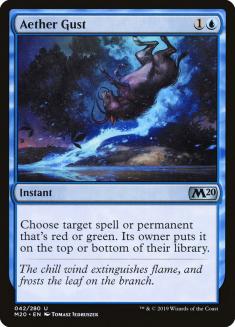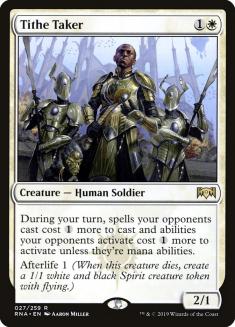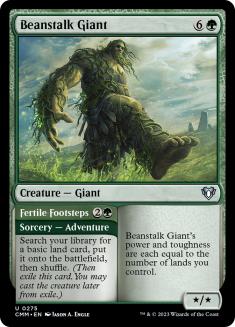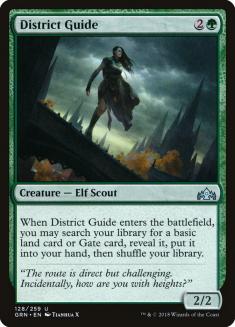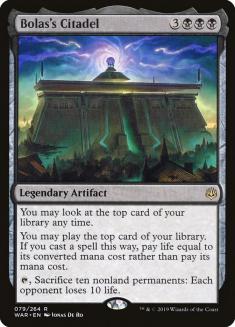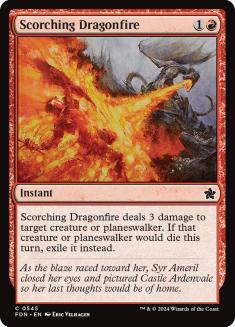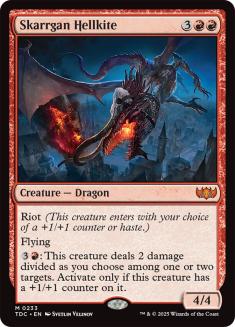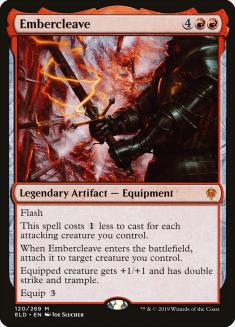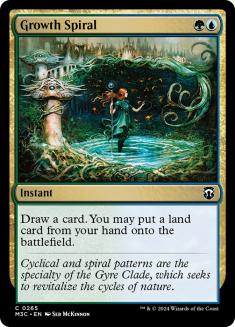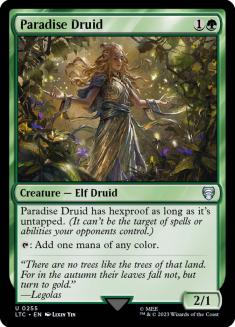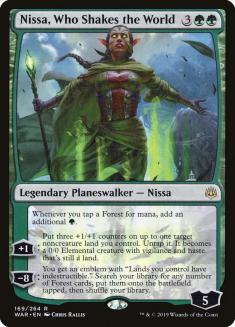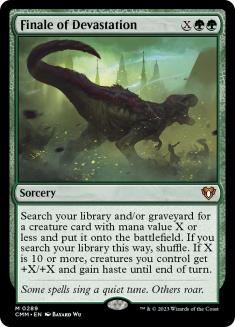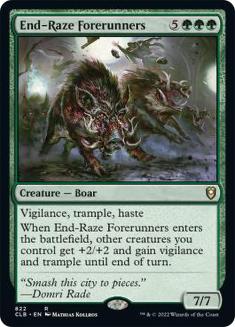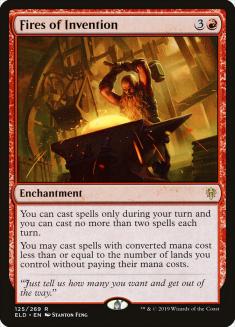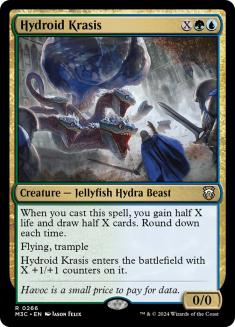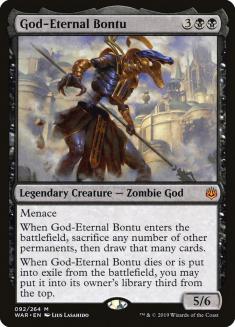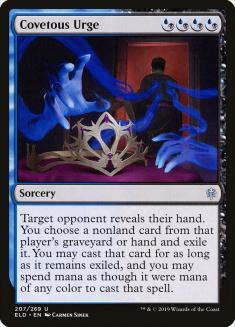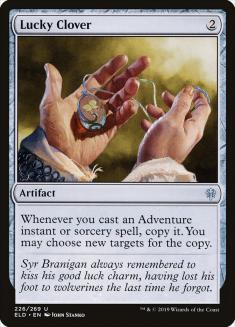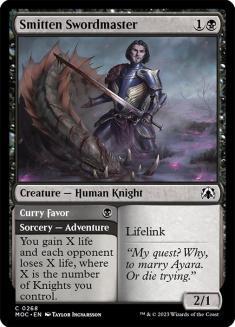By the time you’re reading this Mythic Championship VII will be underway. We’ll be seeing both how pro players choose to build the supposed best decks and what archetypes people think might have a real shot of taking on the top of the metagame. I’m excited to see the results of the weekend, especially as I’m battling in this tournament too, but there are so many sweet things going on with the lists people submitted that I really wanted to take a deep dive into everything going on in the decklists for this event.
Creatures (15)
- 4 Sphinx of Foresight
- 4 Cavalier of Flame
- 3 Cavalier of Gales
- 2 Kenrith, the Returned King
- 2 Bonecrusher Giant
Planeswalkers (4)
Lands (27)
Spells (14)

Creatures (23)
- 4 Midnight Reaper
- 3 Paradise Druid
- 1 Massacre Girl
- 4 Gilded Goose
- 4 Murderous Rider
- 3 Wicked Wolf
- 4 Cauldron Familiar
Planeswalkers (1)
Lands (25)
Spells (11)

Creatures (23)
- 2 Thrashing Brontodon
- 4 Mayhem Devil
- 2 Massacre Girl
- 4 Gilded Goose
- 2 Korvold, Fae-Cursed King
- 3 Beanstalk Giant
- 2 Murderous Rider
- 4 Cauldron Familiar
Lands (25)
Spells (12)

Before we can get to the exciting new decks and unique builds, though, we need to set the stage. Entering this Mythic Championship, Jeskai Fires, Golgari Sacrifice, and Jund Sacrifice were the clear decks to beat. A big part of this came down to how hard it is to meaningfully target these decks. Jeskai Fires shifts roles well in the face of people who push too hard at fighting any individual part of its gameplan, whilst the sacrifice decks can effectively shut down conventional aggression with the Cat-Oven loop whilst grinding out absurd levels of card advantage against anyone not prepared to deal with a cheap enchantment like Trail of Crumbs.
These are my favourite registered versions of each of these archetypes. Unsurprisingly, considering how much attention these decks have had by this point, there is very little new tech to be found here. The most notable finds in the Jeskai Fires lists are maindeck Aether Gusts, which have been an in-and-out-of-fashion feature of the archetype ever since it first appeared months ago, but it’s notable that pros seem to think it’s still a great inclusion right now even with Oko, Thief of Crowns gone from the format. Also notable are a few sideboard inclusions of Tithe Taker as a tool against flash strategies, but I was advocating for this a month ago.
The adoption of Casualties of War in Jund Sacrifice was fairly inevitable as these lists increasingly prepare for mirror-matches. Piotr Glogowski goes one step further by moving from Paradise Druid to Beanstalk Giant in an effort to not have his mana creatures die to opposing Mayhem Devils; meanwhile, Marcio Carvalho does a similar thing by moving towards District Guides instead. Kat Light’s sideboard Drill Bits in her Golgari Sacrifice deck are likely a nod towards how Duress can feel lackluster against the creature-dense nature of Jeskai Fires, whilst Stanislav Cifka Bolas’s Citadels seem potentially awkward against Casualties of War but incredible alongside the sheer amount of lifegain you can get from that deck’s Food production.
Creatures (16)
Lands (26)
Spells (18)
Sideboard

Izzet Flash was already building up a bit of a reputation for itself in the run-up to the Mythic Championship due to supposedly putting up a decent fight against the aforementioned decks-to-beat. I’m still not convinced this is actually the case, with Teferi, Time Raveler being brutal if it ever resolves and the Cat-Oven combo making both Brineborn Cutthroat and Bonecrusher Giant really bad at attacking meaningfully, but so many great players chose to register this archetype that I have to imagine they’re more confident about these matchups.
Notable inclusions among lists here are Scorching Dragonfire as a clean answer to Midnight Reaper or to exile a Cauldron Familiar before the Witch’s Oven hits the battlefield, sideboard Skarrgan Hellkites to allow you to fly over Familiars, and a sideboard Embercleave to just punch through the Familiars instead; lots of tech to help in the Sacrifice matchups, primarily. Antonino De Rosa’s God-Eternal Kefnets are pretty strange to me, as they feel high-risk against all the Brazen Borrowers and Midnight Reapers running around whilst not synergising well with your deck when so many of your instants are either counterspells or come in the form of adventure creatures.
Creatures (8)
Planeswalkers (4)
Lands (27)
Spells (21)

The other side of Gadwick, the Wizened, Azorius Control is actually surprisingly appealing to me, and a lot of that is on the back of Planar Cleansing. Planar Cleansing offers a similar payoff to Casualties of War against the Sacrifice decks and their myriad permanents, but asks that you’re not committing to the battlefield too much yourself. Once you’re designing your deck with that in mind, though, it seems like an effect that’s very much worth pushing into, and I love Kohei Yoshino’s decision to register the full four copies of this card.
Creatures (15)
Planeswalkers (4)
Lands (26)
Spells (15)

Meanwhile, this list is all new tech. I always hated how Simic Flash was built beforehand, but could never really figure out how to fix it; it always felt like so much of the power was in your four-drops, but it was very hard to make the manabase facilitate them properly. I’d considered playing Growth Spiral before, but that doesn’t solve those colour commitment issues, whereas Paradise Druid does.
It means abandoning cards like Brineborn Cutthroat since they compete at similar points on the curve and sit poorly with sorcery-speed spells, but in exchange allows you to play Nissa, Who Shakes the World as another payoff for having all this ramp in your deck. Suddenly your deck attacks from more angles, making playing against it and sideboarding against it that much harder and increasing the number of nut-draws you have the potential to hit. Whether this deck is actually good remains to be seen, but it is certainly very smartly built.
Creatures (20)
- 4 Hydroid Krasis
- 1 End-Raze Forerunners
- 2 Arboreal Grazer
- 4 Risen Reef
- 1 Agent of Treachery
- 4 Leafkin Druid
- 4 Cavalier of Thorns
Planeswalkers (4)
Lands (28)
Spells (8)
Sideboard

Creatures (16)
- 4 Hydroid Krasis
- 2 Incubation Druid
- 4 Paradise Druid
- 1 Massacre Girl
- 2 Gadwick, the Wizened
- 3 Brazen Borrower
Planeswalkers (5)
Lands (27)
Spells (12)

The other Nissa decks in the tournament are wild. Andrea Mengucci’s list is an update of the old Simic Quasiduplicate lists that were running around before rotation, where the aim was to copy your Cavalier of Thorns to rapidly deplete your deck whilst your Risen Reefs dig towards the Nexus of Fates lurking among your increasingly few remaining cards.
With Nexus of Fate gone from the format, a new way of closing out games is needed and Andrea turned to using Finale of Devastation to find a single copy of End-Raze Forerunners to make his team about as large and scary as possible; conveniently this still works even if Cavalier of Thorns mills the Forerunners. One thing I like about Andrea’s build is that with Growth Spiral and Arboreal Grazer as two of the sources of ramp, and a very high land count also, the deck is much more resilient against Deafening Clarion than more mana-creature-heavy builds. Much like with Simic Flash, I’m not sure how good the deck is but I am convinced this is a much better way of building it than what people have been doing previously.
Luis Salvatto’s list is very direct in its approach: make mana to draw cards to make mana to draw cards to…
In matchups where Casualties of War is good, the deck gets an alternative angle of attack, especially as it seems like it can resolve Casualties on Turn 4 fairly reliably, but when that card is bad the deck seems pretty reliant on hoping making a big Hydroid Krasis or pouring mana into Gadwick is good enough.
Creatures (14)
- 3 Hydroid Krasis
- 4 Golos, Tireless Pilgrim
- 2 Agent of Treachery
- 3 Beanstalk Giant
- 2 Kenrith, the Returned King
Planeswalkers (4)
Lands (28)
Spells (14)

Creatures (15)
Planeswalkers (4)
Lands (26)
Spells (15)

The other Growth Spiral decks are where the real spice begins, with two starkly different Five-Color Fires decks. Shota Yasooka’s deck might be the first time I’ve seen Golos, Tireless Pilgrim in a Standard deck since the Field of the Dead ban. It might sound like Golos isn’t what you’d want to be doing in your Fires of Invention deck now that there’s no Field of the Dead in the format, but Golos and Fires secretly work alongside one another to make your draws more consistent; sure, when you hit three spells off your Golos activation, you only get to cast two if there’s a Fires on the battlefield, but in those scenarios two spells is often enough, whereas the times where your Golos activation hits three lands are softened by the fact that Fires means you can still just cast spells from your hand.
Whilst I’m gushing about novel uses of Fires of Invention, Fires with Hydroid Krasis is an interaction I really love, and both these decks feature it. With a Fires on the battlefield you can tap out for your Krasis, drawing a bunch of cards in the process, and then you can immediately cast one of the cards you draw off your Krasis via the Fires of Invention.
It feels like a big motivator for playing either of these decks is wanting to cast Casualties of War as much as possible. Golos activations, Hydroid Krasis, Escape to the Wilds, and Niv-Mizzet Reborn all dig as hard as they can towards your next Casualties of War, and Fires of Invention means you’ll often be able to cast the Casualties the moment you find it. If Standard really is all about removing opposing copies of Fires of Invention, Witch’s Oven, and Trail of Crumbs, this approach makes sense. Meanwhile both decks packing the full four Teferi, Time Raveler feels like a hedge against the flash decks that were already scary to face down even before adding a pile of six-mana sorceries to your deck.
Creatures (24)
- 4 Midnight Reaper
- 4 Mayhem Devil
- 4 God-Eternal Bontu
- 4 Cavalier of Flame
- 4 Cauldron Familiar
- 4 Stormfist Crusader
Lands (26)
Spells (10)
Sideboard

Yet another Fires of Invention variant, yet more nonsense. I’ve seen lists along these lines see a fair bit this last week, and they’ve looked consistently impressive to me. Here Fires takes your Cat-Oven Sacrifice deck and gives it explosive combo-kill potential, with Mayhem Devil turning God-Eternal Bontu into a Fireball, whilst Bontu does the same for your Cavalier of Flame.
Covetous Urge is the one card here I hadn’t seen played before. On the play in Fires of Invention mirrors, it allows you to make sure your opponent can’t land the Fires that they have in their hand, and even when you’re on the draw it still lets you make sure a Casualties of War isn’t coming your way anymore. The fact that John Rolf is going far enough out of his way so as to include four copies of Steam Vents in his manabase to make this card castable without Fires is evidence that he clearly believes in it as both a mirror-breaker and a protection piece.
Creatures (20)
Lands (27)
Spells (13)

Brad Nelson touched on this archetype last week, and Depraz has made some interesting changes to it. Most notably Depraz cut the Edgewall Innkeepers, which sounds absurd at first as Innkeeper is one of the most potent card advantage engines in Standard. However, in this deck, Innkeeper tends to underperform compared to the Golgari Adventures decks we’re used to, with the only Adventure creature that costs less than three mana in this deck being Fae of Wishes. This makes it a sizable amount harder to sneak out Innkeeper alongside an Adventure creature in the early-game, making the card more of a liability in the face of removal as a result, and in the late-game these Temur Adventures decks already have all the card advantage they could possibly need with Escape to the Wilds, Fae of Wishes, and (new to Depraz’s list) Hydroid Krasis. It’s not an obvious change to make to the deck by any means, but the more you think about it, the more it starts to make sense.
Creatures (28)
- 2 Midnight Reaper
- 4 Foulmire Knight
- 4 Smitten Swordmaster
- 4 Order of Midnight
- 4 Lovestruck Beast
- 2 Beanstalk Giant
- 4 Murderous Rider
- 4 Edgewall Innkeeper
Lands (25)
Spells (7)

On a similarly Adventure-themed note, we come to some decks that actually are still playing Edgewall Innkeeper. Most of the Golgari Adventure lists people registered for this tournament are more stock than this, featuring the usual suspects of Questing Beast and Vivien, Arkbow Ranger. Chris Kvartek and Jordan Cairns seem to have both independently come to the same conclusion that they wanted to support The Great Henge via the inclusion of Rotting Regisaur in their Golgari Adventures decks; Rotting Regisaur very much appreciates being given trample by Vivien, Arkbow Ranger, as it happens, especially when it then gets to stomp all over some Cauldron Familiars.
As for myself, I’m leaning in to the power of Lucky Clover for a slightly different approach here. Lucky Clover gives you some powerful bursts of card advantage to help ensure you rarely run out of things to do with your mana, lets you play well against the counterspells in the flash decks, allows Smitten Swordmaster to burn your opponent down out of nowhere, and even makes Casualties of War a more justifiable inclusion by allowing you to ramp into it with Beanstalk Giant, a plan that Reid Duke seems to like so much that he’s playing the full four copies of both Casualties and Beanstalk in his Golgari Adventures list.
Whilst some of the rogue decks can give my build trouble, I’ve been happy with it against the top decks in the field and am excited to already be battling by the time you’re reading this!

